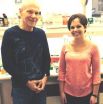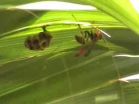(Press-News.org) Jerusalem, Feb. 18, 2014 – Experimental work pointing to a therapy for alleviating mucositis -- a common, severe side effect of chemotherapy and irradiation of cancer patients or patients prepared for bone marrow transplantation – has been achieved by an international team of researchers from the US and Israel headed by scientists at the Hebrew University of Jerusalem.
Mucositis is a strong inflammatory reaction of the mucosal lining of the digestive system, particularly the gut. Mucositis is often a major reason for premature suspension of anti-cancer therapy. As of today, there has been no effective means of preventing mucositis or its treatment.
The research group at the Hebrew University specializes in genetic engineering of mouse models (GEMMs) of inflammation and cancer. Naama Kanarek, a doctoral student at the Lautenberg Center for Immunology and Cancer Research and the Institute for Medical Research Israel–Canada at the Hebrew University Faculty of Medicine, constructed a mouse model designed to study the effect of deleting a gene encoding the enzyme beta-TrCP.
This enzyme was discovered in the laboratory of Hebrew University Prof. Yinon Ben-Neriah 15 years ago, in collaboration with the Israeli Nobel Laureate Prof. Aaron Ciechanover, as a major regulator of inflammatory cascades.
Kanarek found that beta-TrCP deletion in the gut causes mucosal DNA damage, mimicking the effect of chemotherapy and irradiation. Similarly to human patients, she showed that a severe mucositis reaction occurred in mice who were genetically engineered to be beta-TrCP-deficient.
Tracing the pathological basis of the mouse mucositis revealed that the source of the problem was Interleukin-1 (IL-1 beta), a protein secreted by the stressed mucosa. IL-1 beta was found to abnormally open the gut lining, allowing gut bacteria to penetrate and destroy the gut interior. Most importantly was Kanarek's observation that treating the mice with an antibody which blocks IL-1 beta prevents the onset of mucositis in the beta-TrCP-deficient mice.
Based on these findings, the researchers proposed that IL-1b beta blocking reagents, like Anakinra (Kineret), which is used for treating certain chronic inflammatory conditions like rheumatoid arthritis and Crohn's disease, should be tried for preventing mucositis in humans.
INFORMATION:
The work of the researchers was published recently in the American journal PNAS.
New treatment proposed to prevent intestinal inflammation in cancer patients
Research team headed by Hebrew U. scientists
2014-02-18
ELSE PRESS RELEASES FROM THIS DATE:
Increase in Arctic cyclones is linked to climate change, new study shows
2014-02-18
Winter in the Arctic is not only cold and dark, it is also storm season when hurricane-like cyclones traverse the northern waters from Iceland to Alaska. These cyclones are characterized by strong localized drops in sea level pressure, and as Arctic-wide decreases in sea level pressure are one of the expected results of climate change, this could increase extreme Arctic cyclone activity, including powerful storms in the spring and fall.
A new study in Geophysical Research Letters uses historical climate model simulations to demonstrate that there has been an Arctic-wide ...
Saving Sochi's slopes: How artificial snow is made
2014-02-18
WASHINGTON, Feb. 18, 2014 — In what may be the warmest Winter Olympics on record, Sochi looks more like SoCal by the day. With few real snowflakes around to blanket Sochi's slopes, the latest episode of the American Chemical Society's Reactions YouTube series explains how science keeps the Winter Olympics alive with artificial snow. The video is available at http://youtu.be/ftMFMlk6FlA.
Producing artificial snow isn't as simple as grinding up big blocks of ice and spraying it on the slopes. Sochi's artificial snow guns — cannons that fire fake snow 20 to 30 feet in ...
Workers, get up and move
2014-02-18
Are you active at your job? If you're like most workers, you probably aren't. And the consequences could be deadly.
A team of researchers at the University of Iowa measured physical activity in police, whose jobs are presumably predicated on movement. Yet the group found that police officers burn as much energy on the job as someone sitting while holding a baby or washing dishes.
"We find that police work is primarily sedentary," explains Sandra Ramey, assistant professor in the UI College of Nursing. "The public view, how the media portray it on shows like 'Hawaii ...
When a black hole shreds a star, a bright flare tells the story
2014-02-18
Enrico Ramirez-Ruiz uses computer simulations to explore the universe's most violent events, so when the first detailed observations of a star being ripped apart by a black hole were reported in 2012 (Gezari et al., Nature), he was eager to compare the data with his simulations. He was also highly skeptical of one of the published conclusions: that the disrupted star was a rare helium star.
"I was sure it was a normal hydrogen star and we were just not understanding what's going on," said Ramirez-Ruiz, a professor of astronomy and astrophysics at the University of California, ...
Study points out inequalities in prescribing blood pressure meds
2014-02-18
Primary care doctors are not quick to prescribe antihypertensive medication to young people even after an average of 20 months of high blood pressure. Young adults who are white, male, not on Medicaid and not frequent clinic visitors are especially less likely to receive medication. These are the results of a study¹ by a research team at the University of Wisconsin School of Medicine and Public Health in the United States led by Heather Johnson. It appears in the Journal of General Internal Medicine², published by Springer.
One in every 10 Americans between the ages of ...
Blood test serves as 'crystal ball' for heart transplant patients, UCLA-led study finds
2014-02-18
A new UCLA-led study shows that a blood test commonly used to determine whether heart transplant recipients are rejecting their new organ can also predict potential rejection-related problems in the future.
Reporting in the online edition of the peer-reviewed journal Transplantation, researchers demonstrate how the AlloMap test, which uses a blood sample to measure changes in the expression of roughly a dozen genes, can be used over a period of time to assess the risk of dysfunction or rejection of a transplanted heart — months before such an event may occur.
"For ...
The thousand-droplets test
2014-02-18
This news release is available in German. An almost infinite number of complex and interlinked reactions take place in a biological cell. In order to be able to better investigate these networks, scientists led by Professor Friedrich Simmel, Chair of Systems Biophysics and Nano Biophysics at the Technische Universitaet Muenchen (TUM) try to replicate them with the necessary components in a kind of artificial cell. This is also motivated by the thought of one day using such single-cell systems for example as "nanofactories" for the production of complex organic substances ...
Nanodiamond-embedded contact lenses may improve glaucoma treatment
2014-02-18
By 2020, nearly 80 million people are expected to have glaucoma, a disorder of the eye that, if left untreated, can damage the optic nerve and eventually lead to blindness.
The disease often causes pressure in the eye due to a buildup of fluid and a breakdown of the tissue that is responsible for regulating fluid drainage. Doctors commonly treat glaucoma using eye drops that can help the eye drain or decrease fluid production.
Unfortunately, patients frequently have a hard time sticking to the dosing schedules prescribed by their doctors, and the medication — when ...
Ticks may cause double trouble, Stanford scientists find
2014-02-18
As winter turns to spring and many Northern Californians plan outdoor adventures, a mysterious, potentially debilitating threat looms.
A newly recognized human pathogen with unknown health consequences has been found to occur over a large part of the San Francisco Bay Area. A study to be published in the March issue of the journal Emerging Infectious Disease details how researchers including Dan Salkeld, a research associate at the Stanford Woods Institute for the Environment, found the bacterium, Borrelia miyamotoi, as well as Borrelia burgdorferi, the bacterium that ...
What cooperation and conflict in an insect's society can teach us about social acceptance
2014-02-18
VIDEO:
This video shows a female wasp marked with pink paint that was a recently accepted non-nestmate who became a subordinate worker. A resident female flies in and forces the newly...
Click here for more information.
Coral Gables, Fla. (Feb. 17, 2014) -- Ants, wasps and humans live in highly complex societies. Our organizations share some basic features of group life, like individuals trying to find the balance between cooperation and conflict. Understanding what factors are ...
LAST 30 PRESS RELEASES:
Can community awareness campaigns in low-resource areas improve early diagnosis of colorectal cancer?
Stardust study resets how life’s atoms spread through space
Practical education: Clinical scenario-based program development
The impact of family dynamics on eating behaviour – how going home for Christmas can change how you eat
Tracing the quick synthesis of an industrially important catalyst
New software sheds light on cancer’s hidden genetic networks
UT Health San Antonio awarded $3 million in CPRIT grants to bolster cancer research and prevention efforts in South Texas
Third symposium spotlights global challenge of new contaminants in China’s fight against pollution
From straw to soil harmony: International team reveals how biochar supercharges carbon-smart farming
Myeloma: How AI is redrawing the map of cancer care
Manhattan E. Charurat, Ph.D., MHS invested as the Homer and Martha Gudelsky Distinguished Professor in Medicine at the University of Maryland School of Medicine
Insilico Medicine’s Pharma.AI Q4 Winter Launch Recap: Revolutionizing drug discovery with cutting-edge AI innovations, accelerating the path to pharmaceutical superintelligence
Nanoplastics have diet-dependent impacts on digestive system health
Brain neuron death occurs throughout life and increases with age, a natural human protein drug may halt neuron death in Alzheimer’s disease
SPIE and CLP announce the recipients of the 2025 Advanced Photonics Young Innovator Award
Lessons from the Caldor Fire’s Christmas Valley ‘Miracle’
Ant societies rose by trading individual protection for collective power
Research reveals how ancient viral DNA shapes early embryonic development
A molecular gatekeeper that controls protein synthesis
New ‘cloaking device’ concept to shield sensitive tech from magnetic fields
Researchers show impact of mountain building and climate change on alpine biodiversity
Study models the transition from Neanderthals to modern humans in Europe
University of Phoenix College of Doctoral Studies releases white paper on AI-driven skilling to reduce burnout and restore worker autonomy
AIs fail at the game of visual “telephone”
The levers for a sustainable food system
Potential changes in US homelessness by ending federal support for housing first programs
Vulnerability of large language models to prompt injection when providing medical advice
Researchers develop new system for high-energy-density, long-life, multi-electron transfer bromine-based flow batteries
Ending federal support for housing first programs could increase U.S. homelessness by 5% in one year, new JAMA study finds
New research uncovers molecular ‘safety switch’ shielding cancers from immune attack
[Press-News.org] New treatment proposed to prevent intestinal inflammation in cancer patientsResearch team headed by Hebrew U. scientists



